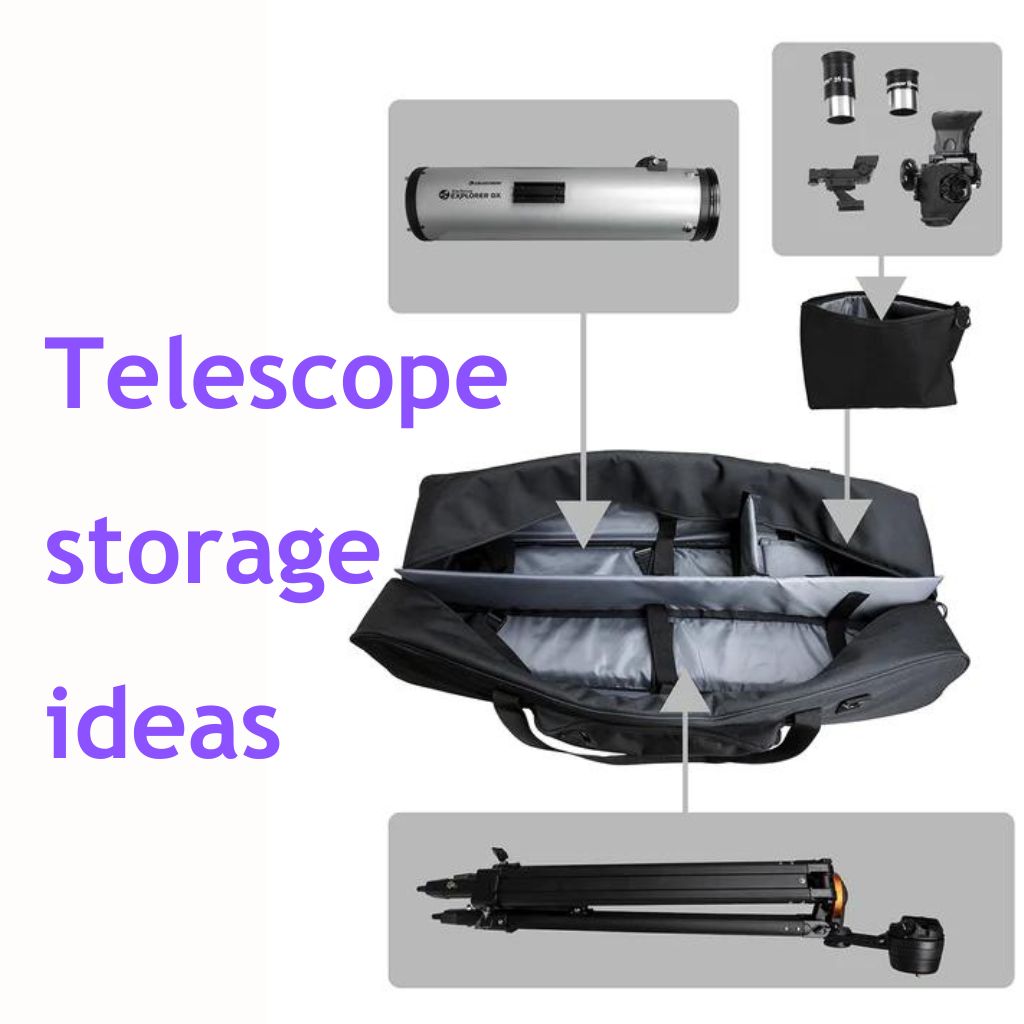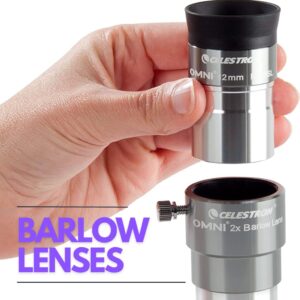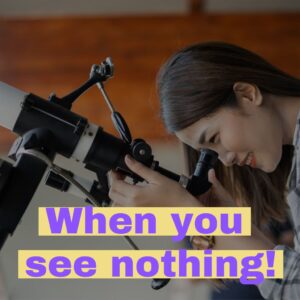This site contains affiliate links to products. I may receive a commission for purchases made through these links.
As an astronomy enthusiast, you know how important it is to keep your telescope in good condition. Proper storage of your telescope can help you avoid costly repairs and prolong its lifespan.
Whether you’re a beginner or a seasoned astronomer, you should know how to store a telescope correctly.
In this post, we’ll discuss these storage Ideas, and it does not matter whether your telescope is a refractor or a reflector. We will also share some telescope accessory storage hacks and more.
Read on!
How to store a telescope based on its type?
Different types of telescopes require diverse storage techniques. Storing a refracting telescope is different from storing a reflecting telescope.
Let’s take a look at how to store each type:
How to store refracting telescope
Refracting telescopes are closed systems with lenses, so you don’t have to worry too much about the dust and dirt coming inside the telescope.
But it is essential always to protect the lenses with dust caps. Refracting telescopes use multicoated lenses, and getting a scratch on the surface of the lens can ruin your refractor telescope.
If you are not using a refactor telescope storage box and want to keep it assembled for quick use, store it in a secured area to avoid kids or pets tipping it over, resulting in broken lenses.
How to store reflecting telescope
All the rules for storing refracting telescopes also apply to reflecting telescope storage. However, since reflecting telescopes are open systems with mirrors, some additional factors must be considered.
In my experience, the dust caps on the reflecting telescope are insufficient to prevent dust from coming inside the telescope.
If you plan to store the telescope assembled without a storage case or dust cover over the whole telescope, the front dust cap can help prevent dust from entering.
However, the problem here is that the primary mirror’s back, where there is a gap between the mirror mounting and the telescope tube, is not sealed and can still be vulnerable to dust.
I recommend using stretch wrap foil to cover dust from entering through the gap in the back of the telescope. This additional layer of protection helps seal the telescope as much as possible and keep dust out.

You can also use stretch wrap foil under the front dust cap for added peace of mind. By taking these extra steps, you can help ensure your reflecting telescope stays clean and functional for years.

You may also like: Reflector vs Refractor Telescope: Which One Do You Need?
How to store telescope eyepieces?
Storing eyepieces is easy if you have dust caps for both ends. In that case, you can place them in a secure spot away from pets and children.
However, it is recommended to store them inside a case for added protection and convenience.
A universal case with foam padding is an excellent choice for storing eyepieces. You can customize the foam to fit your eyepieces and other accessories, keeping them all in one secure location.
This type of case is also helpful for transporting your telescope and accessories to observing locations.
A fantastic universal case on Amazon is HUL 18in Two-Tone Aluminum Case with Customizable Pluck Foam Interior.
But if you buy an eyepiece set like the Celestron – 2” Eyepiece and Filter Accessory Kit, it will come with a neat storage case.
It’s important to note that temperature changes can also affect eyepieces, as they do telescopes. Optics inside eyepieces must re-acclimate to the ambient temperature before and after stargazing sessions to prevent condensation.
To avoid damage to your eyepieces, giving them time to adjust to the temperature before and after each use is a good idea.
This can be done by briefly leaving them in the open air before and after each observing session, allowing them to adjust gradually to the temperature.
What is the ideal temperature to store your telescope?
Maintaining a constant temperature in the storage area or telescope storage bags is essential, as sudden temperature changes can cause condensation on lenses or mirrors.
Avoid storing telescopes in scorching places, as heat can damage the surfaces of mirrors in reflecting telescopes and weaken the glue in compound lenses in refracting telescopes.
Before starting a stargazing session, allow the telescope to acclimate to the ambient temperature outside for the best viewing experience.
After the session, please wait for the telescope to reach room temperature before placing it in the storage case.
This will prevent condensation from forming on the optics inside the storage box. And if you want to be super cautious, you can place a few silica sachets inside the case to control the humidity.
Can I leave my telescope outside?

Unless you have a backyard observatory, leave your telescope inside. Even if you use dust caps or a telescope cover, the weather and temperature changes can still cause damage to the optics.
Moisture, fog, and morning dew can also pose a risk to the telescope, even when it’s not raining. Additionally, the metal parts of the telescope can develop rust if exposed to outdoor elements.
Since telescopes are expensive and delicate instruments, it’s always best to keep them in a safe storage place or case. Don’t be tempted to be lazy and leave them outside.
Can you keep a telescope in a shed?
Keeping the telescope in the shed is a prevalent practice; generally, storing your telescope in a shed is safe. The shed is the best option if you don’t have enough space inside your house.
The only thing to look out for is what material is the telescope storage shed built from.
Metal and plastic sheds will get very hot inside during the summer months. As I said earlier in the article, this is the problem because the high temperature can damage your telescope.
Wooden sheds are the best option because they don’t get as hot as their metal and plastic counterparts. Just keep an eye on it in summer and monitor the temperatures. If they got very high, try to find another place to store the telescope.
You may also like: Can I Use My Telescope Through a Window?
Can you store a telescope in the garage?

Storing your telescope in a garage is a common option, but there are some important things to highlight.
If you’re not using your garage for parking your car, it can be a suitable storage location. However, if your vehicle is inside, it can create problems.
The engine fumes and dust turbulence generated by starting a car are not ideal environments for storing a telescope. Exhaust fumes can leave a hydrocarbon haze on the optics, which can be challenging to clean.
The same issue applies to other machinery you may be using in the garage.
Another concern is pests like mice and spiders.
To prevent cobwebs from accumulating inside the telescope or cables from getting damaged, it’s essential to cover the telescope correctly or store it in a secure storage case.
This issue is also present when storing your telescope in a shed.
Finally, keep in mind the temperature inside the garage during the summer months.
You may also like: Why I Can’t See Anything Through My Telescope?
Should I keep my telescope inside the house?

Some people use their telescopes as room decorations. You might have seen it in movies and tv shows where telescopes are an excellent decoration item in the living room.
It is a perfect option for storing a telescope, especially if you have an expensive one that looks good. Or if you are lucky enough and have your own office at home, you can exhibit it there.
Just ensure there is enough room to walk past it so no one will trip over or tip over your precious scope.
I suggest using your telescope as a home decoration only if you have enough room. You don’t want it to be a hazard for anyone, and also, you don’t want your telescope to get damaged.
In addition, you could build a telescope storage wall that would allow you to hang the telescope in your house, but that depends on if you have a small telescope.
Plus, remember everything I mentioned above about dust caps, etc.
Tips to avoid telescope damage while storing it
Storing a telescope properly is a thing that you should pay attention to. Telescopes use optical lenses and mirrors that have to be protected.
Keeping your telescope size and design in mind, the following are some of the best ways to store a telescope.
1. Disassemble the eyepiece from the main tube before storing
To prevent damage to the glass surface, it is important to disassemble the eyepiece from the main tube before storing it.
Refractor telescopes should not be stored upright without support brackets.
The recommended way to store them is by laying them flat on their side, which also prevents dust buildup on the lens and mirror.
2. Cover all open areas with protective caps or plastic wrap before storing them away
To prevent dust buildup and potential damage to the reflective surface of lenses and mirrors, it is vital to cover all concave optical surfaces with protective caps or plastic wrap before storing your telescope.
When storing an optical tube, it should be elevated off the floor and not have any weight or pressure against its base, as temperature changes can cause warping or cracking over time.
If you notice dirt or grime on your telescope’s housing, applying a light oil to sensitive metal parts may be necessary to prevent corrosion buildup while not in use.
3. Store it in a dry location, out of direct sunlight
When storing your telescope, finding a safe, dry location away from direct sunlight is crucial. Consider keeping it on a closet shelf or a storage compartment under the stairs.
If you have an observatory outside your home, ensure the area around it is enclosed to prevent access by animals or children.
Avoid storing your telescope in damp or humid areas or places with chemicals, such as attics or basements. These locations may cause damage to the optics housing.
To prevent premature deterioration of your instrument, find a dark storage space.
Remember that telescopes are generally large, so ensure you have enough space to store them safely and comfortably.
4. Store the telescope in its storage case
If you don’t use the telescope very often, you can use the original box it came in or buy a dedicated storage case for the telescope.
These cases are not only safe storage, but they are perfect for transporting the telescope. If you plan to bring the telescope on a camping trip or live in the city and you have to travel to the dark side, the storage case is a must.
You can buy a telescope storage bag directly made for the type of telescope you have or build one yourself. It is not too hard.
If you can’t or don’t have the time to build one, this Celestron – Telescope Carrying Case is a beautiful storage case for your telescope.
5. Store your telescope on its side so that it doesn’t collect dust and debris
When storing a telescope, it’s important to keep it off the floor and in a sturdy position to prevent dust and damage from vibrations.
Storing it on its side with enough room around it for expansion is the best option to avoid pressure buildup.
While some suggest keeping expensive models vertically, ensuring they are propped against something solid is crucial to prevent potential damage from gravity pulling down one end over time.
6. Covering your scope with a cloth when not in use is recommended
To prevent dust and debris from getting inside your telescope and causing irreparable damage over time, it’s recommended to cover it with a dust sheet or cloth when not in use.
This is especially important if you are yet to have any other means of insulating your equipment from changes in temperature and humidity.
You can use a simple cotton bed sheet, but you must replace it regularly due to dust particles sticking to fabric surfaces quickly.
Additionally, investing in a protective cabinet with an airtight seal, like those used by professional astronomers, can provide sufficient ventilation while keeping out moisture and dirt.
7. Do not leave the telescope mount outside
Leaving the telescope mount outside is also not a good idea. If you think that it is safe, you are wrong.
The mount is an essential part of the whole telescope setup. It must be protected, too, especially if we are talking about motorized mounts that include many electronics and gears easily damaged by outside weather.
But if yours is a manual mount that is relatively inexpensive, you can leave it on the porch under the roof if you cover it with a waterproof cover. It will survive, but I highly recommend keeping everything inside dry.
8. Rotate the telescope occasionally during long-term storage
To prevent unnecessary strain on the moving parts of your telescope, it’s recommended that you periodically rotate it when storing it for extended periods.
This helps to avoid uneven weight distribution. Additionally, be mindful of the weight placed on the main tube to prevent damage to the telescope over time.
Smart storage solutions for your telescope
In addition to the above tips, here are more storage solutions for your telescope.
Telescope storage bags
If you don’t use the telescope often, you can use the original box it came in or buy a dedicated storage case. These cases are not only safe storage, but they are perfect for transporting the telescope.
If you plan to bring the telescope on a camping trip or live in the city and you have to travel to a dark site, the storage case is a must.
You can buy a telescope storage bag directly made for the type of telescope you have or make one yourself. It is not too hard.
If you can’t or don’t have the time to make one, check out:
- Celestron – Telescope Carrying Case
- GoHimal Shock-Absorbent Telescope Bag
Refractor telescope storage box
A refractor telescope storage box is a great way to protect your telescope. It’s designed to keep your telescope pieces organized and ready for use.
It also helps to keep out dust, dirt, and moisture so your telescope stays clean and dry.
Excellent examples of such telescope storage boxes are:
- CAMINSTARRY Aluminum Alloy storage box
- USA Gear Refractor Telescope Case Bag
Telescope storage wall
The storage wall might be a great solution if you’re short on space. It’s a vertical storage option that allows you to hang your telescope on the wall, freeing up floor space.
It is not a popular solution. However, it is a smart one.
To get a storage wall, you will have to go through the DIY route, as no manufacturer presently makes one. If you are good with your hands, then give it a try.
However, do note that telescopes on a wall mount are not as protected from dust and humidity; hence, ensure they are well protected using dust covers such as:
- NEWFOM Telescope Cover
- Orion 15206 Cloak Cover
- COOSOO Telescope Cover
Storage for telescope mount counterweights
Counterweights are an essential part of a telescope mount and play a crucial role in maintaining balance during observation. But when it comes to storage, they are often neglected.
To prevent rust and corrosion, it is crucial to store them correctly.
These bags or boxes are made of soft velvet, shock-absorbing sponge, thick pearl cotton, and water-resistant polyester, which protect the counterweights from moisture and dust.
Using this counterweight storage bag or box is an excellent way to extend the lifespan of your counterweights, ensuring they remain in good condition for a long time.
These are Counterweight storage bags on Amazon that will suit your needs:
- Samdew Large Telescope travel bag
- Bagmate Rhino R8 Pro Telescope Bag
Telescope filter storage cases
Filters are an essential accessory for your telescope and must be stored correctly. Just like the lens storage box, a filter storage case is a compact and protective storage solution for your filters.
The case is usually made of durable materials and lined with foam padding to prevent damage to the filters.
As always, Celestron has some excellent Telescope filter storage cases. Some available options are:
- Celestron Telescope Eyepieces and Filter case
- CelticBird 13 Piece Telescope Accessory Kit
Takeaway: Utilize these telescope storage hacks to improve its longevity
Correctly storing your telescope is essential to its longevity and performance.
Remember that extreme temperatures can harm your telescope lenses/mirrors; leaving your telescope outside is ideal only if you have an observatory or a shed.
Please take note of these 8 telescope storage ideas discussed in this piece, so your telescope can serve you for a long time.If you want to learn how to transport a telescope, check out this post: Can I Take a Telescope as Hand Luggage? (Answered!)



















